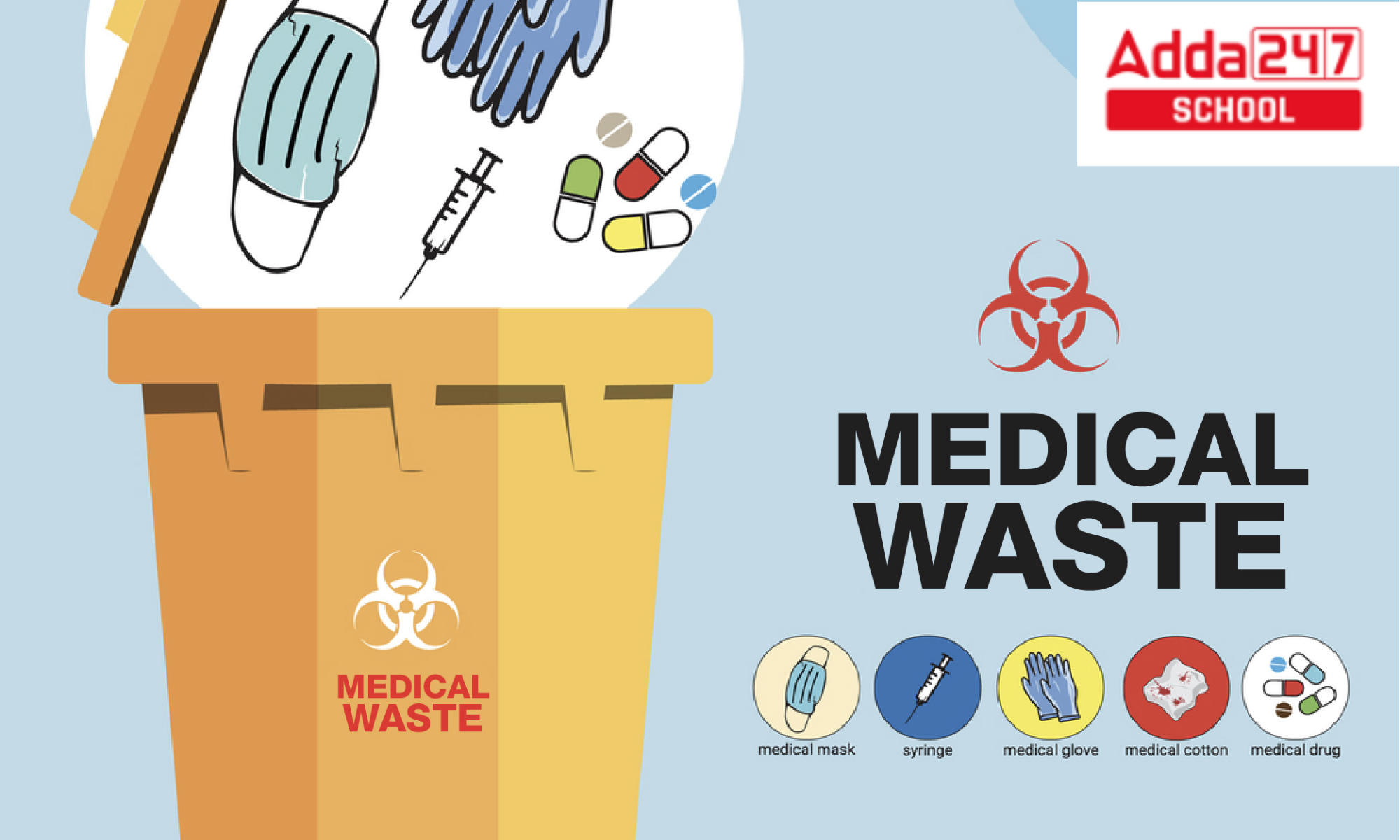Table of Contents
Biomedical Waste Management
Biomedical waste management involves the proper handling, disposal, and treatment of waste materials generated in healthcare facilities, research laboratories, and other medical settings. It refers to a collection of practises intended to reduce the risks connected with biomedical waste, such as infectious diseases and environmental damage. In this essay, we will look at the significance of biomedical waste management as well as the key principles and practices involved.
Also check, Disaster Management Project for Class 9 &10, PDF Download
Biomedical Waste Management Project Definition
Bio-medical waste management was first governed by the Bio Medical Waste Management and Handling Rule, 1998, and its following changes. The Bio-medical Waste Management and handling regulation 2016 is now in effect.
Bio-medical waste is any waste generated during the diagnosis, treatment, or immunization of humans or animals, or during related research activities, as well as the manufacture or testing of biological products in health facilities.
The term “bio medical waste” refers to all waste generated by healthcare facilities that, if illegally disposed of, could harm either human health or the environment as a whole. All rubbish that endangers human health or the environment is considered contagious and must be treated as such.
Also Read, Windmill Project for Kids Explanation
Biomedical Waste Definition
Biomedical waste, also known as healthcare waste or medical waste, refers to any waste material that contains biological or infectious agents. This includes discarded items such as used syringes, needles, bandages, laboratory cultures, human tissues, blood, and other bodily fluids. Biomedical waste may also include non-biological materials like chemicals, pharmaceuticals, and radioactive substances used in medical procedures.
Read More, Volcano Project for Kids, Eruption Science Explanation
Importance of Biomedical Waste Management
Proper biomedical waste management is essential for several reasons:
a) Preventing the Spread of Infections: Biomedical waste, especially infectious materials, can harbor pathogens that pose a risk to human health. Effective management practices, such as segregation, disinfection, and proper disposal, minimize the potential for disease transmission among healthcare workers, patients, and the general public.
b) Environmental Protection: Biomedical waste contains hazardous substances that can contaminate soil, water bodies, and the air if not managed properly. By implementing appropriate waste management strategies, the release of toxic chemicals, pathogens, and pharmaceutical residues into the environment can be minimized, safeguarding ecosystems and public health.
c) Compliance with Regulations: Governments and regulatory bodies have established guidelines and regulations for biomedical waste management to ensure public safety and environmental protection. Healthcare facilities are legally obligated to adhere to these regulations to avoid penalties and maintain their reputation.
Also Read, Fluid Mosaic Model of Plasma Membrane, Diagram
Biomedical Waste Management Principle
a) Segregation: The first step in effective waste management is the segregation of different types of biomedical waste. This involves categorizing waste into different color-coded containers based on their characteristics, such as infectious, sharp, chemical, or pharmaceutical waste. Segregation facilitates proper handling, treatment, and disposal of waste materials.
b) Collection and Storage: Biomedical waste should be collected and stored in secure containers that are leak-proof, puncture-resistant, and labeled appropriately. These containers should be placed at designated locations within healthcare facilities to ensure safe and convenient waste disposal.
c) Transportation: Biomedical waste must be transported from healthcare facilities to treatment or disposal facilities in a manner that prevents leakage, spillage, or exposure. Specialized vehicles and trained personnel should be employed for the transportation of biomedical waste, following strict safety protocols.
d) Treatment and Disposal: Biomedical waste requires proper treatment to inactivate pathogens and reduce its potential harm. Common treatment methods include incineration, autoclaving (steam sterilization), chemical disinfection, and microwaving. After treatment, the waste can be disposed of through landfilling, deep burial, or other approved methods.
Read More, Lava Lamp Experiment Ingredients, Aims, Explanation for kids
Best Practices in Biomedical Waste Management
a) Staff Training: Healthcare personnel should receive regular training on the proper handling, segregation, and disposal of biomedical waste. Training should include awareness about potential hazards, infection control measures, and the use of personal protective equipment (PPE).
b) Monitoring and Auditing: Regular monitoring and auditing of biomedical waste management practices ensure compliance with regulations and identify areas for improvement. This includes tracking waste generation, segregation practices, storage conditions, and treatment processes.
c) Public Awareness: Public awareness campaigns can help educate the general population about the proper disposal of biomedical waste generated at home, such as sharps or expired medicines. Clear instructions and convenient collection systems can be provided to encourage responsible waste disposal.
d) Collaboration and Partnerships: Governments, healthcare facilities, waste management authorities, and environmental organizations should collaborate to establish effective biomedical waste management systems.
Biomedical Waste Management Assignment Explanation
Any garbage that contains infectious or possibly contagious elements is considered biomedical waste. These wastes are produced when humans and animals are diagnosed, treated, and immunized. There are both solid and liquid kinds of biomedical waste. Biomedical waste examples include: Waste sharps, including broken glass, scalpels, lancets, syringes, and used needles, bodily parts or recognisable human tissues (as a result of amputation), Veterinary hospital trash and animal tissues, used gloves, dressings, bandages, other medical equipment, contaminated areas’ liquid waste, and waste from the lab. Biomedical wastes must be treated and disposed of differently than ordinary waste.
Types of Biomedical Waste
Biomedical waste is divided into eight categories by the World Health Organization (WHO):
- Infectious Waste
- Sharps objects
- Pathological Waste
- Pharmaceutical Waste
- Genotoxic Waste
- Radioactive Waste
- Chemical Waste
- General/Other Waste
Biomedical Waste Management in Hospital
Biomedical waste in Hospitals include waste from human anatomy, including tissues, organs, and body parts
animal waste produced by veterinary hospitals during research, wastes from microbiology and biotechnology, Sharps waste, such as used scalpels, syringes, and hypodermic needles, discarded medications, cytotoxic medications, trash that has been contaminated with blood, such as dressings, bandages, plaster casts, tubes, and catheters, liquid waste from each affected region, and Chemical wastes and incinerator ash.
Utilizing various sorts of containers to collect biological waste from places like operating rooms, labs, wards, kitchens, and hallways is part of the process. It is important to arrange the bins and containers such that 100% collection is obtained.
Biomedical Waste Management Project/ Assignment
Introduction to Bio-Medical Waste (BMW)
All human endeavours result in garbage. We are all aware that this waste could be toxic and needs to be disposed of properly. Polluted water, land, and air, as well as industrial and agricultural waste. Both humans and the environment may be at risk from it.
Similar to this, hospitals and other healthcare institutions produce large amounts of garbage that can spread diseases to anyone who handle it or come into touch with it, including HIV, Hepatitis B and C, and Tetanus.
Definition of BioMedical Waste
Any waste that is produced during the diagnosis, treatment, or immunization of humans or animals, in related research activities, or in the manufacturing or testing of biologicals, as defined by the Biomedical Waste (Management and Handling) Rules, 1998 of India.
Classification of BioMedical Waste
Medical waste is divided into eight categories by the World Health Organization (WHO): general waste, pathological waste, radioactive waste, chemical waste, infectious to possibly contagious waste, sharps waste, pharmaceutical waste, and waste in pressurized containers.
Sources of Biomedical Waste
Hospitals generate waste, which has grown in both quantity and variety over time. In addition to being a risk to patients and the staff who manage them, hospital waste also poses a risk to the environment and public health.
- hospitals, whether public or private, nursing homes, or dispensaries.
- primary care facilities.
- paramedical services, medical schools, and research facilities.
- Animal research facilities and veterinary colleges.
- mortuaries, blood banks, and autopsy facilities.
- Institutes for biotechnology.
- unit of production.
- clinics for doctors and dentists.
- slaughterhouses for animals.
- camps for blood donation.
- vaccine facilities.
- Psychiatric facilities, cosmetic piercing, and acupuncturists.
- funeral arrangements.
- institutions for people with disabilities.
Treatment of Biomedical Waste Management
1. Chemical Processes
These procedures make use of disinfectant-acting compounds. Examples of such compounds include ozone, hydrogen peroxide, per-acetic acid, sodium hypochlorite, dissolved chlorine dioxide, and dry inorganic chemicals. The majority of chemical reactions require neutralising agents and a lot of water.
2. Thermal Processes
Heat is used in these procedures to disinfect. Low-heat systems and High-heat systems have been divided into two categories based on the temperature at which they function. Steam, hot water, or electromagnetic radiation are used in low-heat systems (which run between 93 and 177°C) to heat and cleanse the waste.
3. Mechanical Processes
To make trash handling easier or to process waste in conjunction with other treatment stages, these methods are used to alter the physical shape or features of the waste. The key two mechanical operations are
- Compaction: used to lessen the amount of waste
- Shredding: used to prevent the reuse of plastic and paper waste by destroying it. A shredder can only be used with waste that has been disinfected.
4. Irradiation Processes
Wastes should be exposed to ultraviolet or ionising radiation in a sealed space. To make the garbage unidentifiable in these systems, post shredding is necessary.
5. Biological Processes
treating medical waste with biological enzymes. In addition to decontaminating the waste, it is asserted that biological reactions will also cause the elimination of all organic components, leaving only plastics, glass, and other inert materials in the residues.
Health Hazards of Biomedical Waste Management
The WHO reports that the average life expectancy in the world is rising. However, the number of fatal infections is rising. According to a WHO research, infectious diseases claim the lives of more than 50,000 people every day.
Ineffective waste management is one of the factors contributing to the rise in infectious diseases. The majority of viruses, bacteria, and parasites that cause illness are found in blood, body fluids, and bodily secretions, which are components of biomedical waste.
Biomedical Waste Management Assignment Project PDF
Here we give bio medical waste management assignment project pdf for the students. check now
Also Read:
- Health Ministers Of India List From Independence To 2022
- How Many Liters In A Gallon Of Water?- In India, UK, US
- Sustainable Development Project, Definition, Example, PDF For Class 10
- Oscillatory Motion, Meaning, Definition, Example, Diagram
- SSC Full Form In 10th School Education In Hindi And English
- Heterogeneous Mixture- Meaning, Definition & Example For Class 9
- My Best Friend Essay In English 200 Words For Boys/Girls PDF
- Important Question Of Physics Class 12 With Answers
- Parenchyma- Cells, Tissue, Meaning, Function, And Diagram
- What Is Hybridization?- Sp3, Sp2, Examples And Formula



 NEET Organic Chemistry Syllabus 2025, Ch...
NEET Organic Chemistry Syllabus 2025, Ch...
 NTA NEET Exam Date 2025 OUT, Exam Timing...
NTA NEET Exam Date 2025 OUT, Exam Timing...
 Class 10th result 2025 MP Board Announce...
Class 10th result 2025 MP Board Announce...










